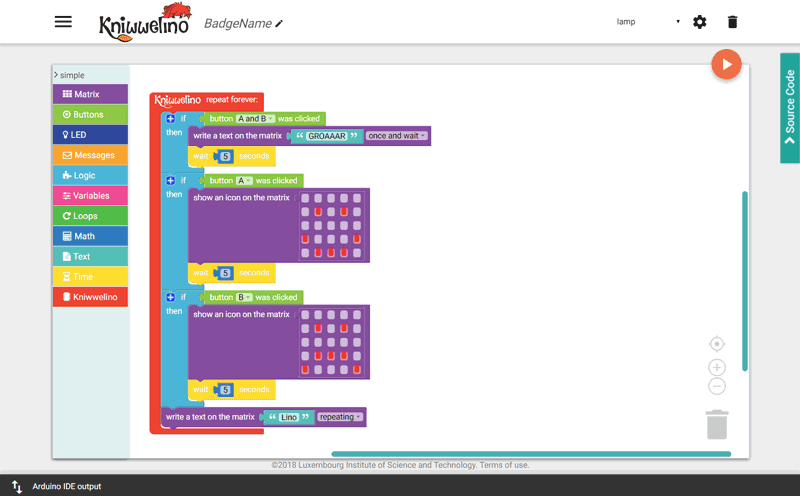by Valérie Maquil and Christian Moll (Luxembourg Institute of Science and Technology)
The Luxembourg Institute of Science and Technology (LIST) has developed Kniwwelino, a microcontroller-based development platform that uses a visual programming interface to help children discover programming and electronics in a creative and hands-on approach.
Computational thinking skills are considered fundamental for our future daily lives. One approach to foster these skills is to introduce primary school children to programming and electronics through platforms that are easy to use, engaging and fun. Kniwwelino® [L1][1] is a platform that teaches computational thinking in a way that is attractive and interesting to children, while being accessible and easy to use.
Kniwwelino is a microcontroller-based learning environment consisting of a set of printed circuit boards (PCBs), an Arduino Library and a visual programming interface. The main PCB, the Kniwwelino board, proposes a 5×5 LEDs matrix, an RGB LED and two push buttons (see Figure 1). The microcontroller has Wi-Fi connectivity, enabling several boards to connect over the internet. Additional PCBs can be used as extensions and include different sensors and actuators, such as an LED, a buzzer, a potentiometer, an ultrasonic distance sensor, a touch button, or a temperature sensor. They can be connected to the main board via alligator clips or other types of wires.

Figure 1: The Kniwwelino board contains a 5×5 LEDs matrix, an RGB LED, two push buttons and several pins for connecting additional hardware.
To program the hardware, a Kniwwelino Library [L2] is available as well as a visual programming interface [L3] (see Figure 2) accessible via the web browser. In this interface, pieces of code are represented by blocks and users can assemble their programs using drag and drop, like the pieces of a puzzle.
The firmware is distributed to the Kniwwelino board wirelessly via WiFi. This has the advantage that no installation of drivers or software is required and any type of device (laptop, desktop and tablet) and operating system can be used.

Figure 2: In the visual programming interface, users can assemble their programs using drag and drop, like the pieces of a puzzle.
Kniwwelino provides a creative and hands-on approach to programming and electronics. Children can rebuild, customise and invent a variety of projects combining technological with non-technological components. Example projects include a wristband to send messages and icons to friends or a weather station that shows current weather conditions available on the internet.
Kniwwelino was developed in an iterative, user-centric design approach, building upon results from previous work and taking in account current technologies available on the market. Throughout its development, Kniwwelino was tested with more than 2,000 children who attended workshops organised at different fairs. Participants provided feedback via a short questionnaire.
The Kniwwelino workshops were equally attended by girls and boys, the majority of whom had never coded before. Most participants found the Kniwwelino workshops very fun and the included tasks relatively easy. They would like to use Kniwwelino again and to try other programming tools.
Currently, LIST is collaborating with seven primary and secondary schools in Luxembourg to evaluate the feasibility of using Kniwwelino in the Luxembourg’s classrooms. Every pilot school was provided with a classroom kit containing in total 15 pupil boxes, each including a Kniwwelino board, 14 different extensions, and cables to connect them. They also received a handbook with pedagogical activities, projects to build and creative material to support pupils in developing new projects. Over the coming months, teachers will test these materials in their classrooms and document their impressions and experiences.
Kniwwelino was developed by the Luxembourg Institute of Science and Technology (LIST) in collaboration with the National Youth Service (Service National de la Jeunesse – SNJ), a government organisation in charge of non-formal education in Luxembourg, as well as SCRIPT, a government organisation responsible for formal education. The project is supported by the Luxembourg National Research Fund (FNR) under the PSP Flagship (2016-2019) and Jump POC (2019-2020) schemes.
Links:
[L1] https://www.kniwwelino.lu/
[L2] https://github.com/kniwwelino
[L3] https://code.kniwwelino.lu
Reference:
[1] V. Maquil, et al.: “Kniwwelino: A Lightweight and WiFi Enabled Prototyping Platform for Children”, in Proc. of the 12th International Conference on Tangible, Embedded, and Embodied Interaction, pp. 94-100, ACM, 2018.
Please contact:
Valérie Maquil
Luxembourg Institute of Science and Technology, Luxembourg











